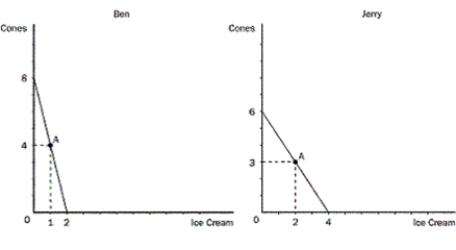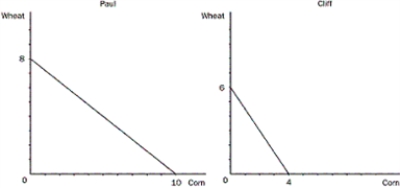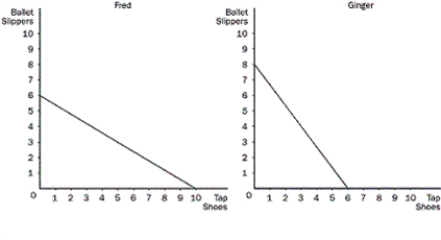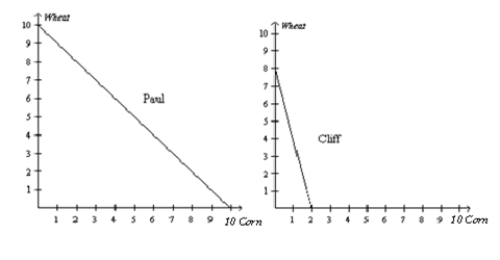A) Ginger has an absolute advantage in ballet slippers, and Fred has an absolute advantage in tap shoes.
B) Ginger has an absolute advantage in tap shoes, and Fred has an absolute advantage in ballet slippers.
C) Ginger has an absolute advantage in neither good, and Fred has an absolute advantage in both goods.
D) Ginger has an absolute advantage in both goods, and Fred has an absolute advantage in neither good.
F) A) and B)
Correct Answer

verified
Correct Answer
verified
True/False
Mark is a computer company executive and earns $200 per hour managing the company and promoting its products. His daughter Regan is a high school student and earns $12 per hour helping her grandmother on the farm. Mark's computer is broken. He can repair it himself in one hour. Regan can repair it in 10 hours. Mark has a comparative advantage repairing the computer.
B) False
Correct Answer

verified
Correct Answer
verified
Multiple Choice
 -Refer to Table 3-2. How could the farmer and rancher both benefit?
-Refer to Table 3-2. How could the farmer and rancher both benefit?
A) by the farmer specializing in meat and the rancher specializing in potatoes
B) by the farmer specializing in potatoes and the rancher specializing in meat
C) by the farmer specializing in neither good and the rancher specializing in both goods
D) by the farmer specializing in both goods and the rancher specializing in neither good
F) All of the above
Correct Answer

verified
Correct Answer
verified
Multiple Choice
Figure 3-3
Ice cream and cones are measured in kilograms.
 -Refer to Figure 3-3. For Ben, what is the opportunity cost of 1 kg of ice cream?
-Refer to Figure 3-3. For Ben, what is the opportunity cost of 1 kg of ice cream?
A) 1/4 kg of cones
B) 1/2 kg of cones
C) 2 kg of cones
D) 4 kg of cones
F) A) and C)
Correct Answer

verified
Correct Answer
verified
True/False
Adam Smith developed the theory of comparative advantage as we know it today.
B) False
Correct Answer

verified
Correct Answer
verified
Multiple Choice
What happens when countries specialize according to their comparative advantage?
A) It is possible to increase world output of all goods.
B) It is possible to increase world output of some goods only by reducing the output of others.
C) One country is likely to gain from trade while others lose.
D) All countries will lose from trade.
F) A) and D)
Correct Answer

verified
Correct Answer
verified
True/False
Differences in opportunity cost allow for gains from trade.
B) False
Correct Answer

verified
Correct Answer
verified
Multiple Choice
Figure 3-1
 -Refer to Figure 3-1. What is the opportunity cost of 1 bushel of wheat for Cliff?
-Refer to Figure 3-1. What is the opportunity cost of 1 bushel of wheat for Cliff?
A) 1/3 bushel of corn
B) 2/3 bushel of corn
C) 1 bushel of corn
D) 3/2 bushels of corn
F) A) and C)
Correct Answer

verified
Correct Answer
verified
Multiple Choice
Suppose that a worker in Boatland can produce either 5 units of wheat or 25 units of fish per year, and a worker in Farmland can produce either 25 units of wheat or 5 units of fish per year. There are 10 workers in each country. No trade occurs between the two countries. Boatland produces and consumes 25 units of wheat and 125 units of fish per year, while Farmland produces and consumes 125 units of wheat and 25 units of fish per year. If trade were to occur, Boatland would trade 100 units of fish to Farmland in exchange for 100 units of wheat. If Boatland no longer grew any of its own wheat, how many units of fish could it now consume along with the 100 units of imported wheat?
A) 25 units
B) 75 units
C) 150 units
D) 250 units
F) A) and D)
Correct Answer

verified
Correct Answer
verified
Multiple Choice
 -Refer to Table 3-5. If Canada and Japan trade based on the principle of comparative advantage, what could Japan gain from exporting a car?
-Refer to Table 3-5. If Canada and Japan trade based on the principle of comparative advantage, what could Japan gain from exporting a car?
A) a maximum of 1/6 airplane
B) a maximum of 1/4 airplane
C) a maximum of 1/3 airplane
D) a maximum of 3 airplanes
F) A) and C)
Correct Answer

verified
Correct Answer
verified
Multiple Choice
Assume that Spain has a comparative advantage in fish and Germany has a comparative advantage in cars. What will happen if these two countries specialize and trade according to their comparative advantage?
A) All individuals in both countries will benefit.
B) Spain will specialize in and export cars.
C) Germany will produce more cars than fish in the absence of trade.
D) Germany will produce more fish than cars in the absence of trade.
F) A) and D)
Correct Answer

verified
Correct Answer
verified
True/False
International trade may make some individuals in a nation better off, while other individuals are made worse off.
B) False
Correct Answer

verified
Correct Answer
verified
Multiple Choice
What is the term that means whatever must be given up to obtain an item?
A) efficiency
B) externality
C) opportunity cost
D) equilibrium
F) None of the above
Correct Answer

verified
Correct Answer
verified
Multiple Choice
 -Refer to Table 3-3. What is the opportunity cost of one blanket for Kevin?
-Refer to Table 3-3. What is the opportunity cost of one blanket for Kevin?
A) 1/5 sweater
B) 1/4 sweater
C) 1 sweater
D) 5 sweaters
F) A) and B)
Correct Answer

verified
Correct Answer
verified
Multiple Choice
 -Refer to Table 3-5. Denmark and Italy trade according to the principle of comparative advantage. If the international price of bread is 2.5 units of cheese for 1 unit of bread, what is the gain from trade to Denmark per unit of bread traded?
-Refer to Table 3-5. Denmark and Italy trade according to the principle of comparative advantage. If the international price of bread is 2.5 units of cheese for 1 unit of bread, what is the gain from trade to Denmark per unit of bread traded?
A) 0.5 units of cheese
B) 1.5 unit of cheese
C) 2.0 units of cheese
D) 2.5 units of cheese
F) A) and C)
Correct Answer

verified
Correct Answer
verified
Multiple Choice
Figure 3-5
These graphs illustrate the production possibilities available for dancing shoes to Fred and Ginger with 40 hours of labour.
 -Refer to Figure 3-5. If Fred and Ginger devote half of their time (20 hours) to the production of each good, what would the total production be?
-Refer to Figure 3-5. If Fred and Ginger devote half of their time (20 hours) to the production of each good, what would the total production be?
A) 7 ballet slippers and 8 tap shoes
B) 8 ballet slippers and 8 tap shoes
C) 9 ballet slippers and 6 tap shoes
D) 10 ballet slippers and 8 tap shoes
F) A) and C)
Correct Answer

verified
Correct Answer
verified
Multiple Choice
 -Refer to Table 3-3. How could Kevin and Amy both benefit?
-Refer to Table 3-3. How could Kevin and Amy both benefit?
A) by Kevin specializing in blankets and Amy specializing in sweaters
B) by Kevin specializing in neither good and Amy specializing in both goods
C) by Kevin specializing in sweaters and Amy specializing in blankets
D) by Kevin specializing in both goods and Amy specializing in neither good
F) A) and C)
Correct Answer

verified
Correct Answer
verified
Multiple Choice
 -Refer to Table 3-1. What does each producer have an absolute or comparative advantage in?
-Refer to Table 3-1. What does each producer have an absolute or comparative advantage in?
A) The farmer has an absolute advantage in potatoes, and the rancher has a comparative advantage in meat.
B) The farmer has an absolute advantage in meat, and the rancher has a comparative advantage in potatoes.
C) The farmer has an absolute advantage in neither good, and the rancher has a comparative advantage in potatoes.
D) The farmer has an absolute advantage in neither good, and the rancher has a comparative advantage in meat.
F) None of the above
Correct Answer

verified
Correct Answer
verified
Multiple Choice
Figure 3-2
 -Refer to Figure 3-2. What do the two producers have an absolute or comparative advantage in?
-Refer to Figure 3-2. What do the two producers have an absolute or comparative advantage in?
A) Paul has a comparative advantage in both wheat and corn.
B) Paul has an absolute advantage in wheat, and Cliff has a comparative advantage in corn.
C) Cliff has a comparative advantage in wheat, and Paul has a comparative advantage in corn.
D) Cliff has a comparative advantage in both wheat and corn.
F) A) and D)
Correct Answer

verified
Correct Answer
verified
Multiple Choice
 -Refer to Table 3-1. What is the opportunity cost of 1 kg of potatoes for the farmer?
-Refer to Table 3-1. What is the opportunity cost of 1 kg of potatoes for the farmer?
A) 9 hours of labour
B) 3 hours of labour
C) 3 kg of meat
D) 1/3kg of meat
F) None of the above
Correct Answer

verified
Correct Answer
verified
Showing 101 - 120 of 202
Related Exams